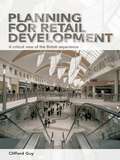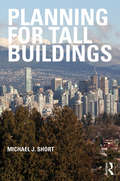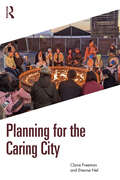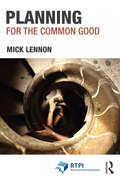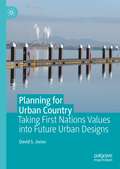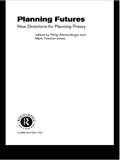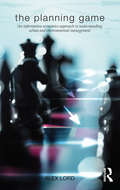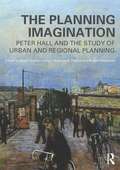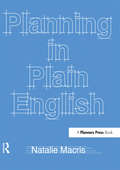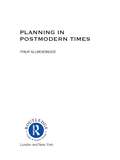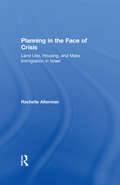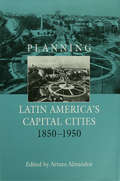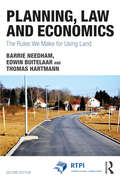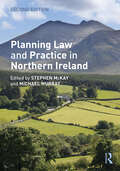- Table View
- List View
Planning for Retail Development: A Critical View of the British Experience
by Clifford GuyWritten by a leading expert in the field, this is the first thorough critical review of retail planning policy in Britain (including Scotland and Wales). It covers recent changes in government policy and guidance, and examines retail policy within a broader economic and social context. Planning for Retail Development explains key events and debates in the evolution of retail planning policy, at central and local government levels, since the 1960s and draws contrasts between the 1980s, a period in which retail developers were encouraged by central government to expand away from town centres, and the more recent emphasis on protection and promotion of town centres as the most appropriate location for new development. The book develops a critical evaluation of past and present retail planning policies, based upon analyses of retailers’ objectives and of typical consumer shopping behaviour. Relationships between retail planning and wider societal concerns, including sustainable development, social inclusion and urban regeneration are also examined and analysed and guidelines for future policy objectives and content are drawn.
Planning for Retail Development: A Critical View of the British Experience
by Clifford GuyWritten by a leading expert in the field, this is the first thorough critical review of retail planning policy in Britain (including Scotland and Wales). It covers recent changes in government policy and guidance, and examines retail policy within a broader economic and social context. Planning for Retail Development explains key events and debates in the evolution of retail planning policy, at central and local government levels, since the 1960s and draws contrasts between the 1980s, a period in which retail developers were encouraged by central government to expand away from town centres, and the more recent emphasis on protection and promotion of town centres as the most appropriate location for new development. The book develops a critical evaluation of past and present retail planning policies, based upon analyses of retailers’ objectives and of typical consumer shopping behaviour. Relationships between retail planning and wider societal concerns, including sustainable development, social inclusion and urban regeneration are also examined and analysed and guidelines for future policy objectives and content are drawn.
Planning for Tall Buildings
by Michael J. ShortIn a time of recession, the challenge of building and planning for tall buildings has become even more complex; the economics of development, legislative and planning frameworks, and the local politics of development must be navigated by those wishing to design and construct new tall buildings which fit within the fabric of their host cities. This book is a timely contribution to the debate about new tall buildings and their role and effect on our cities. It is divided into two main parts. In part one, the relationship between tall buildings and planning is outlined, followed by an exploration of the impacts that construction of tall buildings can have. It focuses, in particular, on the conservation debates that proposals for new tall buildings raise. The first part ends with an analysis of the way in which planning strategies have evolved to deal with the unique consequences of tall buildings on their urban locations. The second part of the book focuses on seven examples of medium-sized cities dealing with planning and conservation issues, and implications that arise from tall buildings. These have been chosen to reflect a wide range of methods to either encourage or to control tall buildings that cities are deploying. The case studies come from across the western world, covering England (Manchester, Liverpool, Newcastle and Birmingham), Norway (Oslo), Ireland (Dublin) and Canada (Vancouver) and represent a broad spectrum of approaches to dealing with this issue.In drawing together the experiences of these varied cities, the book contributes to the ongoing debate about the role of the tall building in our cities, their potential impacts, and experiences of those who use and inhabit them. The conclusions outline how cities should approach the strategic planning of tall buildings, as well as how they should deal with the consequences of individual buildings, particularly on the built heritage.
Planning for Tall Buildings
by Michael J. ShortIn a time of recession, the challenge of building and planning for tall buildings has become even more complex; the economics of development, legislative and planning frameworks, and the local politics of development must be navigated by those wishing to design and construct new tall buildings which fit within the fabric of their host cities. This book is a timely contribution to the debate about new tall buildings and their role and effect on our cities. It is divided into two main parts. In part one, the relationship between tall buildings and planning is outlined, followed by an exploration of the impacts that construction of tall buildings can have. It focuses, in particular, on the conservation debates that proposals for new tall buildings raise. The first part ends with an analysis of the way in which planning strategies have evolved to deal with the unique consequences of tall buildings on their urban locations. The second part of the book focuses on seven examples of medium-sized cities dealing with planning and conservation issues, and implications that arise from tall buildings. These have been chosen to reflect a wide range of methods to either encourage or to control tall buildings that cities are deploying. The case studies come from across the western world, covering England (Manchester, Liverpool, Newcastle and Birmingham), Norway (Oslo), Ireland (Dublin) and Canada (Vancouver) and represent a broad spectrum of approaches to dealing with this issue.In drawing together the experiences of these varied cities, the book contributes to the ongoing debate about the role of the tall building in our cities, their potential impacts, and experiences of those who use and inhabit them. The conclusions outline how cities should approach the strategic planning of tall buildings, as well as how they should deal with the consequences of individual buildings, particularly on the built heritage.
Planning for the Caring City
by Claire Freeman Etienne NelAs the world has become increasingly urbanised and planetary well-being ever more threatened, questions have emerged over just what the priorities should be for how we live in cities. Clearly for many the current ways of planning and managing city environments are not working, given so many of their human and non-human inhabitants struggle on a daily basis to maintain their well-being and survival. Different approaches to city development are crucial if they are to be inclusive places where all can thrive. Ensuring that cities are safe and sustainable and provide a level of care for all their residents places a significant mandate on those who manage cities and on planners in particular. This book examines all the parts of the city where care needs to be incorporated, how we plan, create nurturing environments, include all who live there, build sensitively, support meaningful livelihoods, and enable compassionate governance. With planners in mind this book examines why care is needed in the urban environment, and drawing on real world examples examines how it can be applied in an effective and empowering fashion.
Planning for the Caring City
by Claire Freeman Etienne NelAs the world has become increasingly urbanised and planetary well-being ever more threatened, questions have emerged over just what the priorities should be for how we live in cities. Clearly for many the current ways of planning and managing city environments are not working, given so many of their human and non-human inhabitants struggle on a daily basis to maintain their well-being and survival. Different approaches to city development are crucial if they are to be inclusive places where all can thrive. Ensuring that cities are safe and sustainable and provide a level of care for all their residents places a significant mandate on those who manage cities and on planners in particular. This book examines all the parts of the city where care needs to be incorporated, how we plan, create nurturing environments, include all who live there, build sensitively, support meaningful livelihoods, and enable compassionate governance. With planners in mind this book examines why care is needed in the urban environment, and drawing on real world examples examines how it can be applied in an effective and empowering fashion.
Planning for the Common Good (RTPI Library Series)
by Mick LennonAppeals to the ‘common good’ or ‘public interest’ have long been used to justify planning as an activity. While often criticised, such appeals endure in spirit if not in name as practitioners and theorists seek ways to ensure that planning operates as an ethically attuned pursuit. Yet, this leaves us with the unavoidable question as to how an ethically sensitive common good should be understood. In response, this book proposes that the common good should not be conceived as something pre-existing and ‘out there’ to be identified and applied or something simply produced through the correct configuration of democracy. Instead, it is contended that the common good must be perceived as something ‘in here,’ which is known by engagement with the complexities of a context through employing the interpretive tools supplied to one by the moral dimensions of the life in which one is inevitably embedded. This book brings into conversation a series of thinkers not normally mobilised in planning theory, including Paul Ricoeur, Alasdair MacIntyre and Charles Taylor. These shine light on how the values carried by the planner are shaped through both their relationships with others and their relationship with the ‘tradition of planning’ – a tradition it is argued that extends as a form of reflective deliberation across time and space. It is contended that the mutually constitutive relationship that gives planning its raison d’être and the common good its meaning are conceived through a narrative understanding extending through time that contours the moral subject of planning as it simultaneously profiles the ethical orientation of the discipline. This book provides a new perspective on how we can come to better understand what planning entails and how this dialectically relates to the concept of the common good. In both its aim and approach, this book provides an original contribution to planning theory that reconceives why it is we do what we do, and how we envisage what should be done differently. It will be of interest to scholars, students and practitioners in planning, urban studies, sociology and geography.
Planning for the Common Good (RTPI Library Series)
by Mick LennonAppeals to the ‘common good’ or ‘public interest’ have long been used to justify planning as an activity. While often criticised, such appeals endure in spirit if not in name as practitioners and theorists seek ways to ensure that planning operates as an ethically attuned pursuit. Yet, this leaves us with the unavoidable question as to how an ethically sensitive common good should be understood. In response, this book proposes that the common good should not be conceived as something pre-existing and ‘out there’ to be identified and applied or something simply produced through the correct configuration of democracy. Instead, it is contended that the common good must be perceived as something ‘in here,’ which is known by engagement with the complexities of a context through employing the interpretive tools supplied to one by the moral dimensions of the life in which one is inevitably embedded. This book brings into conversation a series of thinkers not normally mobilised in planning theory, including Paul Ricoeur, Alasdair MacIntyre and Charles Taylor. These shine light on how the values carried by the planner are shaped through both their relationships with others and their relationship with the ‘tradition of planning’ – a tradition it is argued that extends as a form of reflective deliberation across time and space. It is contended that the mutually constitutive relationship that gives planning its raison d’être and the common good its meaning are conceived through a narrative understanding extending through time that contours the moral subject of planning as it simultaneously profiles the ethical orientation of the discipline. This book provides a new perspective on how we can come to better understand what planning entails and how this dialectically relates to the concept of the common good. In both its aim and approach, this book provides an original contribution to planning theory that reconceives why it is we do what we do, and how we envisage what should be done differently. It will be of interest to scholars, students and practitioners in planning, urban studies, sociology and geography.
Planning for Urban Country: Taking First Nations Values into Future Urban Designs
by David S. JonesPlanning for Urban Country addresses a major gap in knowledge about the translation of Aboriginal values and Country Plans into Australia’s built environment contexts. How do you ‘heal’ Country if it has been devastated by concrete and bitumen, excavations and bulldozing, weeds and introduced plants and animals, and surface, aerial and underground contaminants? How then do Aboriginal values and Country Plan aspirations address urban environments? In this book, David Jones explores the major First Nations-informed design and planning transformations in Djilang / Greater Geelong since 2020. Included are short-interlinked essays about the political and cultural context, profiles of key exemplar architectural, landscape and corridor projects, a deep explanation of the legislative, policy and statutory precedents, opportunities and environment that has enabled these opportunities, and the how Wadawurrung past-present-future values have been scaffolded into these changes.
Planning Futures: New Directions for Planning Theory
by Philip Allmendinger Mark Tewdwr-JonePlanning theory is currently in a confused state as a consequence of a number of changes over the last ten years in planning practice and social and economic theory. Even prior to these events, planning theory was an uncertain discipline, reflecting planning's precarious position between and resting upon a range of professional subject areas and philosophical roots. Planning Futures is an attempt to pin down the constantly evolving landscape of planning theory and to chart a path through this fast changing field.Planning Futures is an up-to-date reader on planning theory, but adds something more to the subject area than a mere textbook. The contributors have attempted to bridge theory and practice while putting forward new theoretical ideas. By drawing upon examples from planning practice and case study scenarios, the authors ensure that the work discusses planning theory within the context of present planning practice. Case studies are drawn from an international arena, from the UK, Europe, South Africa and Australia.
Planning Futures: New Directions for Planning Theory
by Philip Allmendinger Mark Tewdwr-JonesPlanning theory is currently in a confused state as a consequence of a number of changes over the last ten years in planning practice and social and economic theory. Even prior to these events, planning theory was an uncertain discipline, reflecting planning's precarious position between and resting upon a range of professional subject areas and philosophical roots. Planning Futures is an attempt to pin down the constantly evolving landscape of planning theory and to chart a path through this fast changing field.Planning Futures is an up-to-date reader on planning theory, but adds something more to the subject area than a mere textbook. The contributors have attempted to bridge theory and practice while putting forward new theoretical ideas. By drawing upon examples from planning practice and case study scenarios, the authors ensure that the work discusses planning theory within the context of present planning practice. Case studies are drawn from an international arena, from the UK, Europe, South Africa and Australia.
The Planning Game: An Information Economics Approach to Understanding Urban and Environmental Management
by Alex LordTrading information is an essential aspect of the negotiations that underpin planning practice across the globe. In this book, Alex Lord uses information economics to outline a way of thinking about these negotiations that places the strategies that actors in the planning game use at the heart of the debate. Dialogue between economics and planning theorists has been, until now, rare. Lord argues that information economics’ tool kit, game theory – including well-known examples such as the Prisoners’ Dilemma, the Stag Hunt game and Follow the Leader – offers an analytical framework ideally suited to unpacking planning processes. This use of game theory to understand how counterparties interact draws together two distinct bodies of literature: firstly the mainstream economics treatment of games in abstract form and, secondly, accounts of actual bargaining in planning practice from a host of international empirical studies. Providing a novel alternative to existing theories of planning, The Planning Game provides an explanation of how agencies interact in shaping the trajectory of development through the application of game theory to planning practice.
The Planning Game: An Information Economics Approach to Understanding Urban and Environmental Management
by Alex LordTrading information is an essential aspect of the negotiations that underpin planning practice across the globe. In this book, Alex Lord uses information economics to outline a way of thinking about these negotiations that places the strategies that actors in the planning game use at the heart of the debate. Dialogue between economics and planning theorists has been, until now, rare. Lord argues that information economics’ tool kit, game theory – including well-known examples such as the Prisoners’ Dilemma, the Stag Hunt game and Follow the Leader – offers an analytical framework ideally suited to unpacking planning processes. This use of game theory to understand how counterparties interact draws together two distinct bodies of literature: firstly the mainstream economics treatment of games in abstract form and, secondly, accounts of actual bargaining in planning practice from a host of international empirical studies. Providing a novel alternative to existing theories of planning, The Planning Game provides an explanation of how agencies interact in shaping the trajectory of development through the application of game theory to planning practice.
The Planning Imagination: Peter Hall and the Study of Urban and Regional Planning (Planning, History and Environment Series)
by Mark Tewdwr-Jones Nicholas A. Phelps Robert FreestoneKnighted in 1998 ‘for services to the Town and Country Planning Association’, and in 2003 named by Her Majesty Queen Elizabeth II as a ‘Pioneer in the Life of the Nation’, Peter Hall is internationally renowned for the breadth and depth of his studies and writings on urban and regional planning. For the last 50 years, he has captured and helped to create the ‘planning imagination’. Here the editors have brought together in five themes a series of critical reflections on Peter’s vast and diverse contributions. Those reflections are provided by colleagues familiar with his work. The five parts are devoted to Peter Hall’s breadth of academic work, covering the history of cities and planning, London, spatial planning, connectivity and mobility, and urban globalization. Finally, as a sixth part, the editors have asked Peter Hall himself to reflect on his career and the sources of his imagination. The story this book tells is not one of a singular, totally consistent theoretical and philosophical view elaborated over several decades. Rather it covers a set of views that necessarily admits signs of Peter’s inconsistency and imperfection over the years – the insights and imperfections that inevitably accompany the exercise of a nonetheless remarkably fertile, restless and inspiring planning imagination.
The Planning Imagination: Peter Hall and the Study of Urban and Regional Planning (Planning, History and Environment Series)
by Mark Tewdwr-Jones Nicholas Phelps Robert FreestoneKnighted in 1998 ‘for services to the Town and Country Planning Association’, and in 2003 named by Her Majesty Queen Elizabeth II as a ‘Pioneer in the Life of the Nation’, Peter Hall is internationally renowned for the breadth and depth of his studies and writings on urban and regional planning. For the last 50 years, he has captured and helped to create the ‘planning imagination’. Here the editors have brought together in five themes a series of critical reflections on Peter’s vast and diverse contributions. Those reflections are provided by colleagues familiar with his work. The five parts are devoted to Peter Hall’s breadth of academic work, covering the history of cities and planning, London, spatial planning, connectivity and mobility, and urban globalization. Finally, as a sixth part, the editors have asked Peter Hall himself to reflect on his career and the sources of his imagination. The story this book tells is not one of a singular, totally consistent theoretical and philosophical view elaborated over several decades. Rather it covers a set of views that necessarily admits signs of Peter’s inconsistency and imperfection over the years – the insights and imperfections that inevitably accompany the exercise of a nonetheless remarkably fertile, restless and inspiring planning imagination.
Planning in Plain English: Writing Tips for Urban and Environmental Planners
by Natalie MacrisIn this volume, the author draws from more than a decade of editing experience to explain how to craft clear, understandable, and highly readable planning documents. The author suggests ways to overcome planners' most common writing foibles: acronymns, jargon, and overuse of the passive voice. And the author provides handy lists to transform mushy nouns into powerful verbs, pare down bloated sentences, and translate ""bureaucratese"" into everyday language. The author even includes practice exercises designed to help you recognize and overcome bad writing habits. But even the best writing skills won't help if your document is organized poorly and aimed at the wrong audience.The author also explains why it's essential to know who your readers are before you start writing and how to organize your work so that it will be easy to understand and use."
Planning in Plain English: Writing Tips for Urban and Environmental Planners
by Natalie MacrisIn this volume, the author draws from more than a decade of editing experience to explain how to craft clear, understandable, and highly readable planning documents. The author suggests ways to overcome planners' most common writing foibles: acronymns, jargon, and overuse of the passive voice. And the author provides handy lists to transform mushy nouns into powerful verbs, pare down bloated sentences, and translate ""bureaucratese"" into everyday language. The author even includes practice exercises designed to help you recognize and overcome bad writing habits. But even the best writing skills won't help if your document is organized poorly and aimed at the wrong audience.The author also explains why it's essential to know who your readers are before you start writing and how to organize your work so that it will be easy to understand and use."
Planning in Postmodern Times (RTPI Library Series)
by Philip AllmendingerPostmodern social theory has provided significant insights into our understanding of society and its components. Key thinkers including Foucault, Baudrillard and Lyotard have challenged existing ideas about power and rationality in society. This book analyses planning from a postmodern perspective and explores alternative conceptions based on a combination of postmodern thinking and other fields of social theory. In doing so, it exposes some of the limits of postmodern social theory while providing an alternative conception of planning in the twenty-first century.This title will appeal to anyone interested in how we think and act in relation to cities, urban planning and governance.
Planning in Postmodern Times (RTPI Library Series)
by Philip AllmendingerPostmodern social theory has provided significant insights into our understanding of society and its components. Key thinkers including Foucault, Baudrillard and Lyotard have challenged existing ideas about power and rationality in society. This book analyses planning from a postmodern perspective and explores alternative conceptions based on a combination of postmodern thinking and other fields of social theory. In doing so, it exposes some of the limits of postmodern social theory while providing an alternative conception of planning in the twenty-first century.This title will appeal to anyone interested in how we think and act in relation to cities, urban planning and governance.
Planning in the Face of Crisis: Land Use, Housing, and Mass Immigration in Israel
by Rachelle AltermanCritics of urban and regional planning argue that it is best suited to manage incremental change. Can a planner's skills and expertise be effective in handling a major crisis and large-scale change? The mass immigration from the former Soviet Union to Israel in the 1990s offers the opportunity to study one of the largest-scale (non-disaster) crisis situations in a democratic, advanced-economy country. This book recounts the fascinating saga of how policymakers and planners at both the national and local levels responded to the formidable demand for housing and massive urban growth. Planners forged new housing and land-use policies, and applied a streamlined (but controversial) planning law. The outputs were impressive. The outcomes and impacts changed the landscape and human-scape of Israel, heightening dilemmas of land use and urban policy in this high-density country.
Planning in the Face of Crisis: Land Use, Housing, and Mass Immigration in Israel (Cities And Regions Ser.)
by Rachelle AltermanCritics of urban and regional planning argue that it is best suited to manage incremental change. Can a planner's skills and expertise be effective in handling a major crisis and large-scale change? The mass immigration from the former Soviet Union to Israel in the 1990s offers the opportunity to study one of the largest-scale (non-disaster) crisis situations in a democratic, advanced-economy country. This book recounts the fascinating saga of how policymakers and planners at both the national and local levels responded to the formidable demand for housing and massive urban growth. Planners forged new housing and land-use policies, and applied a streamlined (but controversial) planning law. The outputs were impressive. The outcomes and impacts changed the landscape and human-scape of Israel, heightening dilemmas of land use and urban policy in this high-density country.
Planning Latin America's Capital Cities 1850-1950 (Planning, History And The Environment Ser.)
by Arturo AlmandozIn this first comprehensive work in English to describe the building of Latin America's capital cities in the postcolonial period, Arturo Almandoz and his contributors demonstrate how Europe and France in particular shaped their culture, architecture and planning until the United States began to play a part in the 1930s. The book provides a new per
Planning Latin America's Capital Cities 1850-1950
by Arturo AlmandozIn this first comprehensive work in English to describe the building of Latin America's capital cities in the postcolonial period, Arturo Almandoz and his contributors demonstrate how Europe and France in particular shaped their culture, architecture and planning until the United States began to play a part in the 1930s. The book provides a new per
Planning, Law and Economics: The Rules We Make for Using Land (RTPI Library Series #Vol. 10)
by Barrie Needham Edwin Buitelaar Thomas HartmannPlanning, Law and Economics sets out a new framework for applying a legal approach to spatial planning, showing how to improve the practice and help achieve its aims. The book covers planning laws, citizens' rights and property rights, asking ‘What rules do we want to make and, where necessary, enforce? And how do we want to apply them in planning practice?’ This book sets out, in general and illustrated with concrete examples, how the three types of law mentioned above are unavoidably involved in all types of spatial planning. The book also makes clear that these laws can be combined in different ways, each way a particular approach to the practice of spatial planning (regulative planning, structuring markets, pro-active planning, collaborative planning, etc.). Throughout, the book shows what legal approaches can be taken to spatial planning, and uses a four-part framework to evaluate the effects of choosing such an approach. The spatial planning should be effective, legitimate, morally just and economically sound. In particular the book details why the economic effects for society are important and how spatial planning affects how the economic resources of land and buildings are used. The book will be invaluable to students and planners to understand the relationship between their actions and the basic principles of the rule of law in a democratic, liberal society.
Planning Law and Practice in Northern Ireland
by Stephen McKay Michael MurrayEach of the jurisdictions within the United Kingdom is constantly refining the operational characteristics of its planning system and while there are some common practices, there are also substantive divergences. In each territory the planning template is shaped within a dynamic political and legal context and thus students and practitioners require an accessible, in-depth and up-to-date literature dealing with this matter. The multi-disciplinary contributors to this expanded Second Edition of Planning Law and Practice in Northern Ireland explore the progression of planning within the region and discuss prominent facets of contemporary development management, development plans, environmental law, property law and professional practice. Consideration is given to the consequences of Brexit for planning in Northern Ireland, devolved government institutional structures for planning, and the post-2015 emergent performance of local authorities in this arena. The book makes an important contribution to the wider literature in this field and, with its extensive citing of statutes and cases, provides an essential resource for students, planning practitioners and researchers.
